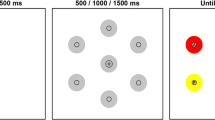Abstract
The present study is concerned with the redundany gain: the observation that subjects respond faster to simultaneously presented redundant targets than to single targets. This finding is usually interpreted as evidence for parallel, self-terminating, unlimited-capacity processing. Alternatively, it has been claimed that the reaction-time advantage with redundant targets is simply due to spatial uncertainty under single-target conditions. The present study tested this hypothesis. In Experiment 1, subjects responded when one, two, or three letters E were presented, and refrained from responding when one, two, or three letters F were presented. In half of the trials, location uncertainty was eliminated by presentation of a line segment at one of the locations of the subsequently appearing target letters. The results reject the alternative spatial-uncertainty explanation: even when the location of the impending target is cued in advance, there is no attenuation of the redundancy gain. Experiment 2 served as a control experiment and showed a clear redundancy gain, even in conditions in which it was ensured that, before display onset, attention was directed to a location of one of the impending targets.
Similar content being viewed by others
References
Bundesen, C. (1990). A theory of visual attention. Psychological Review, 97, 523–547.
Egeth, H. E., Folk, C. L., & Mullin, P. A. (1989). Spatial parallelism in the processing of lines, letters, and lexicality. In B. E. Shepp & S. Ballesteros, (eds.), Object perception: structure & processes. Hillsdale, NJ: Erlbaum.
Eriksen, B. A. & Eriksen, C. W. (1974). Effects of noise letters upon the identification of a target letter in a nonsearch task. Perception & Psychophysics, 16, 143–149.
Eriksen, C. W. & Eriksen, B. A. (1979). Target redundancy in visual search: Do repetitions of the target within the display impair processing? Perception & Psychophysics, 26, 195–205.
Eriksen, C. W., & Hoffman, J. E. (1973). The extent of processing of noise elements during selective encoding from visual displays. Perception & Psychophysics, 14, 155–160.
Fournier, L. R., & Eriksen, C. W. (1990). Coactivation in the perception of redundant targets. Journal of Experimental Psychology: Human Perception and Performance, 16, 538–550.
Jonides, J. (1981) Voluntary vs. automatic control over the mind's eye's movement. In J. B. Long & A. D. Baddeley (Eds.), Attention and performance IX (pp. 187–203). Hillsdale, NJ: Erlbaum.
Krueger, L. E., & Shapiro, R. G. (1980). Repeating the target neither speeds nor slows its detection: Evidence for independent channels in letter processing. Perception & Psychophysics, 28, 68–76.
Mordkoff, J. T., & Yantis, S. (1991). An interactive race model of divided attention. Journal of Experimental Psychology: Human Perception and Performance, 17, 520–538.
Müller, H. J., & Humphreys, G. W. (1991). Luminance increment detection: Capacity limited or not? Journal of Experimental Psychology: Human Perception and Performance, 17, 107–124.
Murphy, T. D. & Eriksen, C. W. (1987). Temporal changes in the distribution of response to precues. Perception & Psychophysics, 42, 576–586.
Theeuwes, J. (1991). Exogenous and endogenous control of attention: The effect of visual onsets and offsets. Perception & Psychophysics, 49, 83–90.
Theeuwes, J. (1993). Visual selective attention: A theoretical analysis. Acta Psychologica, 83, 93–154.
Van der Heijden, A. H. C. (1975). Some evidence for a limited capacity parallel self-terminating process in simple visual search. Acta Psychologica, 39, 21–41.
Van der Heijden, A. H. C. (1992). Selective attention in vision. London: Routledge.
Van der Heijden, A. H. C., LaHeij, W., & Boer, J. P. A. (1983). Parallel processing of redundant targets in simple visual search tasks. Psychological Research, 45, 235–254.
Van der Heijden, A. H. C., Schreuder, R., Maris, L., & Neerincx, M. (1984). Some evidence for correlated separate activation in a simple letter detection task. Perception & Psychophysics, 36, 577–585.
Author information
Authors and Affiliations
Rights and permissions
About this article
Cite this article
Theeuwes, J. The effects of location cuing on redundant-target processing. Psychol. Res 57, 15–19 (1994). https://doi.org/10.1007/BF00452991
Received:
Accepted:
Issue Date:
DOI: https://doi.org/10.1007/BF00452991




